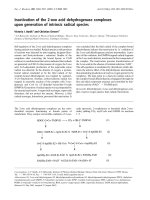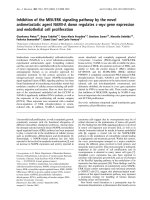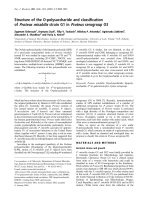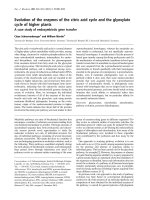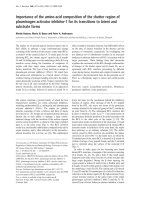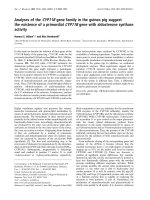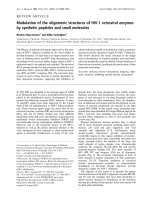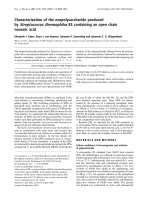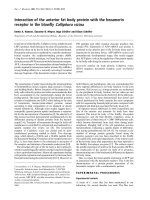Báo cáo y học: " Acceptability of cancer chemoprevention trials: impact of the design" docx
Bạn đang xem bản rút gọn của tài liệu. Xem và tải ngay bản đầy đủ của tài liệu tại đây (205.11 KB, 4 trang )
Int. J. Med. Sci. 2008, 5
244
International Journal of Medical Sciences
ISSN 1449-1907 www.medsci.org 2008 5(5):244-247
© Ivyspring International Publisher. All rights reserved
Research Paper
Acceptability of cancer chemoprevention trials: impact of the design
Anne-Sophie Maisonneuve
1, 2
, Laetitia Huiart
1, 2
, Laetitia Rabayrol
1, 2
, Doug Horsman
3
, Remi Didelot
4
,
Hagay Sobol
1, 2
, Francois Eisinger
1, 2, 3
1. Institut Paoli-Calmettes, Department of Oncogenetics Prevention and Screening Marseille France (FE, ASM, LH, LR, HS)
2. INSERM U 599, Marseille France (FE, ASM, LH, LR, HS)
3. Hereditary Cancer Program British Colombia Cancer Agency (FE, DH)
4. Local Administration of the National Health Insurance System – “Centre d’Examen de Sante (CESAM 13) ” Marseille
France (RD)
Correspondence to: Francois Eisinger, Institut Paoli-Calmettes – INSERM UMR 599 232 Bd St Marguerite 13009 Marseille France. Tel
33 491 22 35 41; fax 33 491 22 38 57; francois.eisinger@ inserm.fr
Received: 2008.06.27; Accepted: 2008.08.21; Published: 2008.08.22
Background: Chemoprevention could significantly reduce cancer burden. Assessment of efficacy and
risk/benefit balance is at best achieved through randomized clinical trials.
Methods: At a periodic health examination center 1463 adults were asked to complete a questionnaire about their
willingness to be involved in different kinds of preventive clinical trials.
Results: Among the 851 respondents (58.2%), 228 (26.8%) agreed to participate in a hypothetical chemopreven-
tion trial aimed at reducing the incidence of lung cancer and 116 (29.3%) of 396 women agreed to a breast cancer
chemoprevention trial. Randomization would not restrain participation (acceptability rate: 87.7% for lung cancer
and 93.0% for breast cancer). In these volunteers, short-term trials (1 year) reached a high level of acceptability:
71.5% and 73.7% for lung and breast cancer prevention respectively. In contrast long-term trials (5 years or more)
were far less acceptable: 9.2% for lung cancer (OR=7.7 CI
95%
4.4-14.0) and 10.5 % for breast cancer (OR=6.9 CI
95%
3.2-15.8). For lung cancer prevention, the route of administration impacts on acceptability with higher rate 53.1%
for a pill vs. 7.9% for a spray (OR=6.7 CI
95%
3.6-12.9).
Conclusion: Overall healthy individuals are not keen to be involved in chemo-preventive trials, the design of
which could however increase the acceptability rate.
Key words: Research Design, Randomized Controlled Trials, Behavior, Attitude, Preventive Health Services, Prevention &
Control, Neoplasms, Breast, Lung
Introduction
Cancer control requires therapeutic and preven-
tive innovations. Biomedical ‘upstream’ actions like
vaccination [1] or chemoprevention [2] could signifi-
cantly reduce cancer burden.
Efficacy, risks and benefits of such interventions
are currently assessed by different means, of which
randomized clinical trial is the gold standard. For
preventive purposes this methodology requires (with
respect to the annual rate of end-points) a large num-
ber of person-years in order to reach a fair discrimi-
natory power.
In an ongoing randomized trial comparing two
screening strategies we observed that 1000 persons
had been interviewed in order to enroll 1.4 persons
where 9 were eligible [3]. Based-on that experience we
wanted to have more information on critical factors
that will help to increase that (low) acceptation rate.
We decided to come back to the same population
having been offered an actual screening trial asking
them their opinion about different modalities of a fu-
ture preventive trial. When considering the feasibility
of such trials in the general population, information
regarding the absolute and differential rates of ac-
ceptability according to different study designs repre-
sent valuable data.
Survey based on questionnaire or observed par-
ticipation rate usually focused on patient perspectives:
the impact of actual and perceived risk of being af-
fected [4], the fear of side effects [5], psychological
factors among which “worry” [6], demographic [7],
and socio cultural or ethnic criteria [8]. The effect of
physician recommendation also had been assessed
[6,9]. All these factors impact on persons’ decision and
multiple barriers exist [8]. We assumed that besides
Int. J. Med. Sci. 2008, 5
245
these characteristics, different study designs are also
relevant factors to consider.
Materials and Methods
The administrative organization within France
relies on Regions: 25 with a mean population of about
2 400 000 inhabitants; range: 160 000 (Guyane)-11 000
000 (Ile de France). In almost every Region, the French
National Health Insurance (Caisse National
d’Assurance Maladie) set up a “Health Center”
(“Centre de Sante”) to promote prevention and
screening of diseases. Once every 5 years, these centers
sent invitations to all affiliated persons (working peo-
ple, former or retired workers and their families). For 8
years now, invitations are extended to the whole
population living in France through the Universal
Health Coverage System (“Couverture Medicale Uni-
verselle”).
We carried out a descriptive survey in the peri-
odic health center located in Marseilles France. Be-
tween January 2003 and May 2003, we included con-
secutive clients (both women and men) over the legal
age of 18 who agreed to participate in the survey.
Subjects were given a written description of the
survey and were asked to complete, on site, a three
part self-administrated questionnaire. The responses
were elicited on a sheet of paper.
The first part recorded the socio-demographic
variables and some general information (familial his-
tory, belief in the efficacy of treatments…). The second
investigated the willingness to participate in a lung
cancer chemoprevention trial depending on different
design options: randomization, trial duration (years),
and route of administration for lung cancer prevention
(pill versus spray). The third part, intended for women
only, investigated the willingness to participate in a
breast cancer chemoprevention trial with the same
design options. The questionnaire was built after a
pilot phase with a face-to-face interview of 98 persons
(these questionnaires were not used in the analysis
presented).
One critical ethical issue about clinical trials is the
acceptability of randomization and how lay people
understand it [10]. In our questionnaire that issue was
framed as: “To test the actual efficacy of a drug among 100
persons, 50 will receive the drug and 50 will receive a drug
without effect (i.e. a pill that looks the same but is ineffec-
tive). Knowing that, would you still agree to participate in
this trial?” This wording had been upheld after the
pilot phase designed to increase actual understanding
and to decrease the impact of how the question was
phrased [11]. Information about the meaning of ran-
domization was also disclosed in the initial informa-
tion sheet that described the offer to participate in the
survey.
Social desirability bias cannot however been ex-
cluded [12].
CHI2 statistic tests (two-sided) and logistic re-
gression were computed using SPSS v11.0. For women,
willingness to participate in a trial (breast or lung
cancer prevention) has been tested for correlation with
willingness to participate in the other study (lung or
breast), to have a quantitative assessment of this rela-
tionship and also, due to the concept of preferential
risk aversion, whereby some individuals may be re-
luctant to participate in some kinds of trial but agree
for different circumstances [13]. The other main a priori
was that family history of a cancer might be an impe-
tus to become involved in a preventive clinical trial.
The aim of this survey was to obtain descriptive
data, and the results should be seen as preliminary but,
from our perspective, will help to raise hypotheses
deserving to be tested. Since no explicative goals were
pursued no sample size was calculated [14].
The survey has been carried out according to the
French legislation related to medical research and did
not require a National or local IRB approval since data
were strictly anonymous. Taking in account the advice
of a local Ethical Board, an information sheet was de-
livered to the clients of the Periodic Health Center. The
client returned (or didn’t) the questionnaire filled or
unfilled without any intervention of the staff aiming at
increasing the response rate.
Results
During the recruitment period, 1463 question-
naires were distributed at the health examination cen-
ter, 545 questionnaires were not returned or blank
(without either explication or comment from the
non-responding individuals), 918 (63%) were com-
pleted. Partial respondents and subjects who declared
a personal cancer history were excluded. The statistical
analysis was carried out on 851 questionnaires (re-
sponse rate 58 %). The main characteristics of the
sample are: 429 male (50.5%); mean age: 45.2 y; 36.5%
with college graduation or higher and 234 current
smokers (27.8%).
Among the 851 respondents, 228 (26.8%) would
agree to participate in a lung cancer chemoprevention
trial. Men (31.9%) agreed more often than women
(21.4%) OR=1.7 95%CI 1.2-2.4. Using univariate analy-
sis among men, tobacco exposure was the only factor
associated with the willingness to participate (OR=2.3
95%CI 1.4-3.9). In a multivariate analysis among
women, for lung cancer two factors were associated
with a higher rate: agreement to participate in breast
Int. J. Med. Sci. 2008, 5
246
cancer prevention trial (OR=84.3 95%CI 36.6-193.8) and
being single (OR=2.2 95%CI 1.1-4.6).
Among 396 women, 116 (29.3%) declared agree-
ment to participate in a breast cancer chemoprevention
trial. Three factors were associated with agreement:
willingness to participate in a lung cancer prevention
trial (OR=103 95%CI 43-247), positive familial history
of breast cancer (OR=3.2 95%CI 1.4-6.9), and trust in
therapeutic efficacy (OR=2.1 95%CI 1.0-4.2) (table 1).
Table 1 Individual factors associated with the willingness to be
involved in a preventive clinical trial. (Multivariate analysis
using logistic regression)
Options Person’s
positions
Lung cancer
prevention
male N=429 *
Lung cancer
prevention
female N=378
Breast
cancer
preven-
tion
N=373
Tobacco expo-
sure
Yes ver-
sus no
OR 2.3
(1.4-3.9)
NS NS
Willingness to
be involved in
an other pre-
ventive trial
Yes ver-
sus no
NA OR 84.3
(36.6-193.8)
OR 103
(43-247)
Familial history
of related cancer
Yes ver-
sus no
NS NS OR 3.2
(1.4-6.9)
Trust in the
therapeutic
efficacy
Yes ver-
sus no
NS NS OR 2.1
(1.0-4.2)
Being single Yes ver-
sus no
NS OR 2.2
(1.1 4.6)
NS
Older Age ** Yes ver-
sus no
NS NS NS
Higher Educa-
tional level ***
Yes ver-
sus no
NS NS NS
* Univariate analysis (Chi2), since only one factor was found sig-
nificant, no multivariate analysis was carried out
**1 Above the lower quartile i.e. above 29 y old for the pooled
population and above 31 y for female population (the case of breast
cancer prevention)
***2 College or higher
The main result of this survey was that the level
of acceptability exhibits huge differences according to
the design of the trial (table 2). In the sub-group of
volunteers, we observed a high acceptability rate for
randomization: 87.7% for lung cancer and 93.0% for
breast cancer. Short term trials (1 year) reached a high
level of acceptability with 71.5% and 73.7% for lung
and breast cancer prevention respectively, while long
term trials (5 years or more) were far less acceptable:
9.2% for lung cancer (OR=7.7 95%CI 4.4-14.0) and 10.5
% for breast cancer (OR=6.9 95%CI 3.2-15.8).
Among the 851 males and females, only 21 per-
sons (2.5%) would agree to be randomized in a clinical
trial looking at lung cancer prevention lasting 5 years
or more. Among the 396 women in our sample only 12
(3.0%) would agree with a similar long-term trial for
breast cancer prevention.
For lung cancer the route of administration of the
active product made a difference, with a higher ac-
ceptability rate of an “ubiquitous” pill: 53.1%, far
higher than the “disease-specific” spray 7.9% (OR=6.7
95%CI 3.6-12.9).
Table 2 Impact of the design of the trial on the acceptability rate
in volunteers for a chemo-preventive trial.
Options Person’s
positions
Lung cancer
prevention
N=228
Breast cancer
prevention
N=114*
Agree 200 (87.7%) 106 (93.0%) Randomization
Disagree
22 (9.6%) 8 (7.0%)
1 y or less 163 (71.5%) ** 84 (73.7%) ***
2-3 y 24 (10.5%) 10 (8.8%)
Time length
(Trial duration)
5 y or more 21 (9.2%) 12(10.5%)
Pill 121 (53.1%) **** -
Spray 18 (7.9%) -
Kind of treatment
(Route of admini-
stration)
Indifferent
77 (33.8%) -
* Among the 116 women who agreed to be involved in a
chemo-preventive trial, 114 filled the part of the questionnaire re-
garding the trial options.
* for lung cancer prevention. Difference between 1 year or less and 5
years or more OR=7.7 95% CI 4.4-14.0
** for breast cancer prevention. Difference between 1 year or less and
5 years or more OR=6.9 95% CI 3.2-15.8
*** for lung cancer prevention. Difference between “a pill” and “a
spray” OR=6.7 95% IC 3.6-12.9
Discussion
On average, regardless the kind of survey, ac-
ceptability rate is low and may even be lower in the
non-respondents group due to psychological or social
differences [15]. This low rate has been reported in
various survey, 34.0% for breast cancer prevention
(actual trial) [6] or even lower 22.1% (willingness to
participate) [7].
These data contrast with highly accepted and
performed chemoprevention of cardiovascular dis-
eases [16]. Already in the late eighties, 84% of the per-
sons with hypertension were aware of it, 73% under
treatment and 55% controlled [17]. However looking
backward in the past, drug management of risk was
not that easy to achieve. Indeed, in the early sixties
48% of the persons with hypertension were aware of it,
30% under treatment and only 12% controlled [17]. As
far as cancer prevention is concerned, it is not possible
to know yet whether a similar shift towards higher
acceptability will occur as preventive action takes time
to implement (education, information, communica-
tion) or if cancer risk mitigation is under different de-
cision-making pattern.
Randomization has been reported to reduce the
willingness of patients to be involved in clinical trials
[18]. Interestingly, our results show a high acceptabil-
ity rate for randomization. Three hypotheses may ex-
Int. J. Med. Sci. 2008, 5
247
plain this opposition. First a cultural difference [19]
could steer the meaning of randomization and its
connection with fate. Second the difference between
attitudes and behaviors [20]. Lastly maybe some par-
ticipants didn’t really understand the meaning of the
question, despite the fact that it was the item on which
attention had been focused on during the pilot phase
of that survey. An argument against this last hypothe-
sis is that there was no statistical difference in the rate
according to the level of education (data not shown).
If confirmed, the major result of our survey is the
huge impact of the duration of the trial on the accept-
ability rate. People agree with short-term trials of one
year or less and disagree strongly with longer trials.
These data are coherent with the observed drop-out
rates in preventive trials [21]. If confirmed, this pro-
vides advice to “clinical trial designers” and pharma-
ceutical companies to look for intermediate end points
[22,23] or short-term interventions, which could be
recurrent. In this respect, for the targeting of apoptosis
[24], a kind of ‘wash-out’ intervention could therefore
be both efficient and acceptable.
Acknowledgement
Funding was provided by Paoli-Calmettes Insti-
tute (Regional Cancer Clinics) – Comité Départemental
des Bouches du Rhone de La Ligue contre le Cancer
(Charities).
A preliminary and shorten version of this paper
had been published as “Persons’ Enrollment and Fol-
low-Up. The Prevention Weakest Link.” Abstract A103
Proceedings of the Frontiers in Cancer Prevention Re-
search Conference. October 26-30, 2003 Phoenix AZ.
Conflict of Interest
The authors have declared that no conflict of in-
terest exists.
References
1. Goldie SJ, Kohli M, Grima D, Weinstein MC, Wright TC, Bosch
FX, et al. Projected clinical benefits and cost-effectiveness of a
human papillomavirus 16/18 vaccine. J Natl Cancer Inst
2004;96:604-15.
2. Freedman AN, Graubard BI, Rao SR, McCaskill-Stevens W,
Ballard-Barbash R, Gail MH. Estimates of the number of US
women who could benefit from tamoxifen for breast cancer
chemoprevention. J Natl Cancer Inst 2003;95:526-32.
3. Eisinger F, Giordanella JP, Brigand A, Didelot R, Jacques D,
Schenowitz G, et al. Cancer prone persons. A randomized
screening trial based on colonoscopy: background, design and
recruitment. Fam Cancer 2001;1:175-9.
4. Bober SL, Hoke LA, Duda RB, Regan MM, Tung NM. Deci-
sion-making about tamoxifen in women at high risk for breast
cancer: clinical and psychological factors. J Clin Oncol
2004;22:4951-7.
5. Port ER, Montgomery LL, Heerdt AS, Borgen PI. Patient reluc-
tance toward tamoxifen use for breast cancer primary preven-
tion. Ann Surg Oncol 2001;8:580-5.
6. Rondanina G, Puntoni M, Severi G, Varricchio C, Zunino A,
Feroce I, et al. Psychological and clinical factors implicated in
decision making about a trial of low-dose tamoxifen in hormone
replacement therapy users. J Clin Oncol 2008;26:1537-43.
7. Bastian LA, Lipkus IM, Kuchibhatla MN, Weng HH, Halabi S,
Ryan PD, et al. Women's interest in chemoprevention for breast
cancer. Arch Intern Med 2001;161:1639-44.
8. Herberman RB, Pearce HL, Lippman SM, Pyenson BS, Alberts
DS. Cancer chemoprevention and cancer preventive vaccines a
call to action: leaders of diverse stakeholder groups present
strategies for overcoming multiple barriers to meet an urgent
need. Cancer Res 2006;66:11540-9.
9. Rouch D, Mayer I, Truica C. Barriers to chemoprevention of
breast cancer with tamoxifen. J Clin Oncol 2005;23(suppl 16S):
1010.
10. Kerr C, Robinson E, Stevens A, Braunholtz D, Edwards S, Lilford
R. Randomisation in trials: do potential trial participants under-
stand it and find it acceptable? J Med Ethics 2004;30:80-4.
11. Singer S, Gaba D, Geppert J, Siniako A, Howard S, Park K. The
culture of safety: results of an organization-wide survey in 15
California hospitals. Qual Saf Health Care 2003;12:112-118.
12. Motl RW, McAuley E, DiStefano C. Is social desirability associ-
ated with self-reported physical activity? Prev Med
2005;40:735-9.
13. Weber E, Blais A-R, Betz N. A domain-specific risk-attitude
scale: measuring risk perceptions and risk behaviors. Journal of
Behavioral Decision Making 2002;15:263 - 290.
14. Bacchetti P. Peer review of statistics in medical research: the
other problem. Bmj 2002;324:1271-3.
15. Montano DE, Selby JV, Somkin CP, Bhat A, Nadel M. Accep-
tance of flexible sigmoidoscopy screening for colorectal cancer.
Cancer Detect Prev 2004;28:43-51.
16. Murphy MJ, Wei L, Watson AD, MacDonald TM. 'Real-life'
reduction in cholesterol with statins, 1993 to 2002. Br J Clin
Pharmacol 2008;65:587-92.
17. Shea S. Hypertension Control, 1994. Am J Pub Health
1994;84:1725-26.
18. Evans D, Lalloo F, Shenton A, Boggis C, Howell A. Uptake of
screening and prevention in women at very high risk of breast
cancer. Lancet 2001;358:889-90.
19. Eisinger F, Geller G, Burke W, Holtzman N. Cultural Basis for
Differences Between US and French Clinical Recommendations
for Women at Increased Risk of Breast and Ovarian Cancer.
Lancet 1999;353:919-20.
20. Extermann M, Albrand G, Chen H, Zanetta S, Schonwetter R,
Zulian GB, et al. Are older French patients as willing as older
American patients to undertake chemotherapy? J Clin Oncol
2003;21:3214-9.
21. Veronesi U, Maisonneuve P, Costa A, Rotmensz N, Boyle P.
Drop-outs in tamoxifen prevention trials. Lancet 1999;353:244.
22. Greenwald P, McDonald SS, Anderson DE. An evidence-based
approach to cancer prevention clinical trials. Eur J Cancer Prev
2002;11 (Suppl 2):S43-7.
23. Vourlekis JS, Szabo E. Predicting success in cancer prevention
trials. J Natl Cancer Inst 2003;95:178-9.
24. Sun SY, Hail NJr, Lotan R. Apoptosis as a novel target for cancer
chemoprevention. J Natl Cancer Inst 2004;96:662-72.
